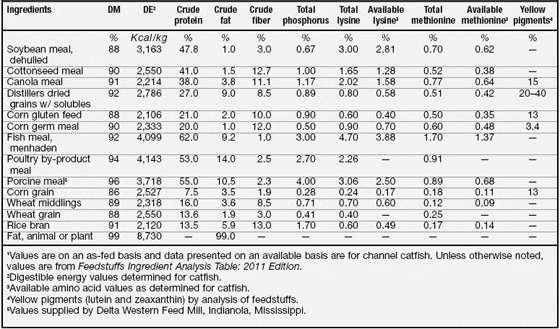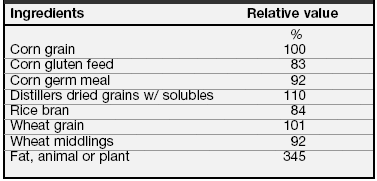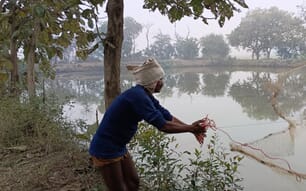A relative comparison of the nutritional value of alternative feedstuffs is presented in this bulletin. The information provided is intended as a guide to the use of these feedstuffs that should be useful to catfish producers, researchers, nutritionists, and feed manufacturers.
Soybean meal and corn typically have been the basis for catfish feeds; however, there are several less expensive alternative feedstuffs that can be used without negatively affecting production. When catfish feeds were reasonably priced, there was little interest in using alternative feedstuffs. However, since the current cost of catfish feed is twice what it was a few years ago, there is strong interest in these products.
From a nutritional standpoint, there are many feedstuffs that might be suitable for use in commercial catfish feeds to provide essential nutrients and energy. In reality, considering price, transportation cost, availability, milling characteristics, and storage limitations, there are few feedstuffs that are economical.
A relative comparison of the values of various protein and energy feedstuffs used for catfish is included in this bulletin. Comparisons are on a relative basis because there can be considerable variations in the actual nutrient content among different batches of a given feedstuff. Soybean meal and corn grain are used as standards to which either protein or energy feedstuffs are compared.
Protein feedstuffs are generally priced on a per-unit-of protein basis, but basing cost on lysine concentration may be more appropriate since it is the first limiting amino acid in plant-based catfish feeds. Methionine is generally the second limiting amino acid. Therefore, we present a relative value for protein feedstuffs based on protein, total and available lysine, and total and available methionine.
Energy feedstuffs are compared based on a digestible energy basis. Other factors that impact quality of feedstuffs, including palatability, milling properties, and concentration of specific nutrients, are also considered. Protein feedstuffs compared in this bulletin include soybean meal, cottonseed meal, canola meal, distillers dried grains with solubles, corn gluten feed, corn germ meal, menhaden fish meal, porcine meal, and poultry by-product meal.
Energy feedstuffs compared are corn grain, wheat grain, wheat middlings, corn gluten feed, corn germ meal, rice bran, and animal and plant fats. Corn gluten feed and corn germ meal are included in both comparisons because they are on the borderline of the definition of a protein feedstuff (20% or more protein) and are used as much for energy as protein.
Protein Feedstuffs
Soybean meal (48% protein) is a high-quality plant protein that has been the primary protein source in commercial catfish feeds from their inception. It has characteristics that are well suited to catfish: It is palatable, highly digestible, high in lysine and good-quality protein, and low in fat and crude fiber (Table 1). Soybean meal sets the standard for catfish feed protein sources. Other plant protein feedstuffs are deficient in one or more indispensable amino acids, particularly lysine. However, when used at proper levels and with lysine supplementation, these feedstuffs can be of value in replacing part of the soybean meal.
Table 1. Values for Dry Matter (DM), Digestible Energy (DE), Protein, Fat, Crude Fiber, Phosphorus, Lysine, And Methionine for Feedstuffs Used in Catfish Feeds.1

Of the protein feedstuffs available, cottonseed meal (41% protein) is most often used to replace soybean meal. On a protein basis, cottonseed meal compares favorably with soybean meal with a relative value of 86. However, on a total lysine basis, its relative value is 55, which indicates that it is severely deficient in lysine (Table 2). On an available lysine basis, the value is even lower at 46 (Table 2). This is partly due to the fact that cottonseed meal contains gossypol, which binds to the lysine and renders it unavailable for metabolism. Free gossypol can be toxic, but its concentration in cottonseed meal is generally too low to harm catfish (Dorsa et al. 1982). Fortunately, supplemental lysine can be used to improve the protein quality of cottonseed meal.
Based on total methionine concentration, cottonseed meal has relative values of 74 and 61 for total and available methionine, respectively (Table 2). However, methionine supplementation is generally not necessary in a typical commercial catfish feed containing cottonseed meal at recommended levels.
The use of cottonseed meal in catfish feeds is also limited because of its high fiber content (Table 1). It is recommended that crude fiber levels not exceed 6–7% of the diet (Robinson et al. 2001), which is supported by recent research (Li at al. 2012). Without lysine supplementation, concentrations of 10-15% cottonseed meal are suitable. When supplemented with lysine, cottonseed meal can comprise up to 25?30% of the diet. It can be used alone or in combination with other feedstuffs, such as corn gluten feed, to replace about half of the soybean meal (Robinson and Li 2008; Li et al. 2011).
Cottonseed meal is a better source of phosphorus than soybean meal (Table 1). Phosphorus found in plant feedstuffs is generally only about one-third available to catfish because it is in the bound form of phytate. But when the diet is supplemented with phytase enzymes, phytate-bound phosphorus is wellutilized by catfish (Li et al. 2004).
Table 2. Relative Nutrient Value of Protein Feedstuffs for Catfish Compared With Soybean Meal on a Protein, Lysine, and Methionine Basis.

Corn gluten feed (21% protein) and corn germ meal (20% protein) are often used in commercial catfish feeds to replace part of the soybean meal and corn grain. They are similar in their concentrations of protein, fat, and crude fiber content, but corn germ meal contains more lysine (Table 1).
Corn germ meal has relative values of 30 and 25 for total and available lysine, respectively. Corn gluten feed has relative values of 20 and 14 for total and available lysine, respectively (Table 2). Corn germ meal also has higher relative values for methionine (Table 2). Despite these differences, they are relatively similar products that can be used at levels up to 30% of the diet when supplemented with lysine. However, corn germ meal has an advantage in that it contains a low concentration of yellow pigments (3.4 ppm), and corn gluten feed contains about 13 ppm (Table 1).
Catfish fed diets containing a concentration of yellow pigments as low as 8 –10 ppm exhibit an undesirable yellow pigmentation of edible tissue (Li et al. 2009). Both feedstuffs are also limited somewhat by their high fiber content. Furthermore, there is some evidence that they may reduce dressed yield of catfish, especially if the diet also contains relatively high levels of cottonseed meal (Li et al. 2012; Li et al. 2013).
Distillers dried grain with solubles (27% protein) has been used sparingly in commercial catfish feeds because the product has typically been highly variable in nutrient content and often too expensive.
Because of the increasing production of ethanol from corn grain, the new generation of distillers grains (DDGS) appears to be of more consistent quality and more competitively priced. DDGS contains significantly less protein and total and available lysine than soybean meal with relative values of 56, 27, and 21, respectively (Table 2). It contains a decent level of methionine with a relative value of 82 and an available value of 68. DDGS contains a higher concentration of phosphorus than soybean meal (Table 1). It appears to be well-utilized by catfish at levels up to 30–40% when the diet is supplemented with lysine (Robinson and Li 2012). Lysine supplementation may not be necessary in diets containing a high level of soybean meal and/or animal protein.
However, the product contains 20–40 ppm of xanthophylls (Table 1) that limit its usefulness as a feedstuff for catfish. Solvent extraction using ethanol reduces the concentrations of yellow pigments, but the added cost may make the product too expensive. In addition, DDGS is relatively high in fat and fiber (Table 1).
Canola meal (38% protein) can be used in catfish feeds but is not generally available at a competitive cost. Its relative protein value is 79, and it has values of 110 and 103 for total and available methionine, respectively. Though it is relatively high in protein and contains as much methionine as soybean meal, canola meal has relative values of only 67 and 56 for total and available lysine, respectively. Canola meal contains a fairly high level of fiber but is a fair source of phosphorus (Table 1). It can be used at levels of 25% with lysine supplementation to replace part of the soybean meal in catfish feeds (Li and Robinson 1995).
Animal protein was included in almost all commercial catfish feeds for many years. However, it is used sparingly today because of its high cost and the fact that most research shows it is not needed in grow-out diets. Animal protein feedstuffs are generally highly palatable, high in protein and essential amino acids, and a good source of phosphorus and other minerals. Fish meals made from whole fish are particularly good sources of nutrients. For example, menhaden fish meal (62% protein) has relative values of 130 for protein and 157 and 138 for total and available lysine, respectively (Table 2). For methionine, their total and available relative values are 274 and 221, respectively. Of course, its nutritional value is reflected in its high price, and thus other, less expensive animal protein sources have been used to replace fish meal. These include poultry byproduct meal and meat and bone meals.
The latter is now restricted to meals derived from porcine products because of concerns about “mad cow disease,” which is caused by an organism found in infected cows.
Both products are high in protein and good sources of essential amino acids and phosphorus (Table 1). The poultry by-product meal (53% protein) used in our comparison is a feed-grade product, which has relative values of 110 for protein and 75 for total lysine (Table 2). The value for lysine may appear low, but it is an average value for a feed-grade product. There is a pet-grade meal that is of better quality, but it is generally not available and is too expensive for use in catfish feeds.
The nutrient content of the porcine meal (55% protein) used in our comparison was provided by the manufacturer for a specific meal that is currently available for use in catfish feeds. It has relative values of 113 for protein, 102 for total lysine, and 89 for available lysine (Table 2). Other porcine meals that are blended to contain a specific nutrient profile are sometimes used. Both poultry by-product meal and porcine meal have high relative values for methionine (Table 2). Animal protein feedstuffs are generally excellent sources of nutrients for catfish, but their use is limited by cost. If used, they rarely exceed 3–5% of the diet.
Energy Feedstuffs
Corn grain has been the standard energy source used in catfish feeds. Corn grain contains at least as much digestible energy as other energy feedstuffs derived from plant material, and it is relatively low in fat and crude fiber (Table 1). Because of a dramatic increase in corn prices in recent years, other less expensive feedstuffs are used whenever possible. Aside from energy and nutrient content, it is important to consider pellet quality when replacing corn grain with other energy feedstuffs. Corn grain has favorable characteristics for manufacturing a high-quality feed pellet that is water-stable and floats on the surface of the pond.
Traditionally, at least 25% corn grain has been used in catfish feeds to ensure proper gelatinization of starch and expansion of feed pellets to produce a stable, floating product. However, levels as low as 15% may be acceptable. Feed conversion ratio is increased in catfish fed a diet based on cottonseed meal and corn gluten feed in which the amount of corn grain has been reduced to less than 15% (Robinson and Li 2011). Reducing corn grain below 15% may also reduce floatability of feed pellets.
Wheat grain and wheat middlings have relative energy values of 101 and 92, respectively (Table 3), thus they can be used as energy sources in catfish feeds. Wheat grain works well as a binder and provides enough starch for proper gelatinization and expansion of the feed pellets, but because of cost, wheat middlings are generally used. Because of their higher protein content and cost-effectiveness, corn gluten feed and corn germ meal have largely taken the place of wheat products in catfish feeds. On an energy basis, they compare favorably to corn grain with relative energy values of 83 for corn gluten feed and 92 for corn germ meal (Table 3). Both contain less starch than corn grain, but a good-quality pellet can be manufactured using these products when mixed with a minimum of 15% corn grain. As discussed previously, feed manufacturers must be careful to maintain the concentration of yellow pigments below 8 ppm when using corn byproducts.
Table 3. Relative Energy Value for Energy Feedstuffs for Catfish Compared With Corn Grain.

Rice bran has a relative energy value of 84 and can be used as an energy source in catfish feeds at levels of 10–15% of the diet. Rice bran is not used to any extent, at least in Mississippi. It is higher in fat than other plant energy feedstuffs, and it is high in fiber as are corn gluten feed and corn germ meal. Some feed manufacturers contend that rice bran is abrasive and causes excessive equipment wear.
Fats are excellent sources of digestible energy for catfish, but their use is limited because catfish feeds are low in fat. Actually, fat is sprayed on top of catfish feed pellets at a rate of 1.5–2% to reduce feed dust more than to supply energy. High levels of fat, particularly marine fish oil, may impart an undesirable flavor to edible tissue.
Conclusions
Soybean meal has been the primary source of protein used in catfish feeds because of its high quality and cost-effectiveness. But with the ever-increasing price of soybean meal, other plant proteins are being utilized because they are more economical per unit of protein. Cottonseed meal is chief among the alternative feedstuffs currently used in catfish feeds and can be used at levels up to about 25–35% of the diet with the addition of supplemental lysine.
Corn gluten feed, corn germ meal, and to a lesser extent distillers dried grains with solubles are used (generally in combination with cottonseed meal) to replace part of the soybean meal and corn grain in catfish feeds. Corn grain continues to be expensive, making it imperative that less-expensive energy sources be used. However, about 15% of corn grain appears necessary to ensure good pellet quality.
Alternative protein feedstuffs are of lower quality than soybean meal but are more economical on a basis of cost per unit of protein. However, they may not be as economical in terms of total lysine and particularly available lysine. That is, soybean meal is a best buy based on protein content unless the cost of supplemental lysine is factored into the equation. Given the relative low cost of supplemental lysine in comparison to lysine found in soybean meal, it is presently more economical to use alternative protein sources with supplemental lysine than to use soybean meal. Regardless of which alternative plant feedstuffs are used, it appears that only about half of the soybean meal should be replaced.
Animal proteins, particularly whole fish meals, are of higher quality than soybean meal, but high cost basically prohibits their use. Animal-based feedstuffs are a good source of phosphorus, but since they are rarely used, phosphorus must be supplied by plant feedstuffs or by supplements.
Dicalcium phosphate has typically been the supplement of choice in the catfish industry. However, some feed mills are using phytase enzymes to utilize the phytatebound phosphorus in plant feedstuffs, thus avoiding the need for a supplement. This difference is important because the use of phytase decreases fecal phosphorus and therefore the amount of phosphorus released into pond water. On the other hand, the indigestible portion of phosphorus supplements results in an increase in fecal phosphorus. Cottonseed meal, corn gluten feed, and canola meal contain higher levels of total phosphorus than soybean meal.
Given the current state of the catfish industry, it is evident that significantly reducing feed cost is essential to continued profitability. However, the bottom line is that when formulating catfish feeds, quality of various feedstuffs — traditional or alternative — must be considered to ensure that the feed is palatable and digestible, meets or exceeds all nutrient requirements of the fish, and provides optimum growth and feed efficiency.
August 2013


